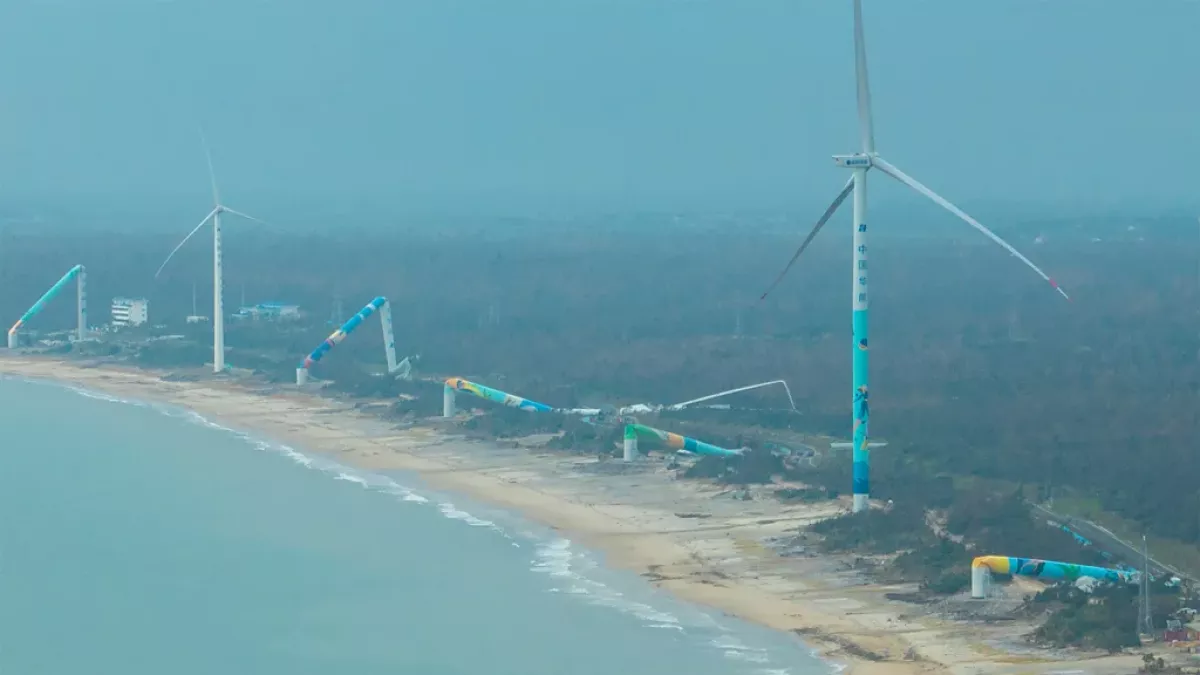China’s push for typhoon-resistant wind power
China is building the world’s most resilient offshore wind farms, with strctures capable not only of surviving but also harnessing the destructive power of tropical cyclones.
As the country pushes forward on its dual-carbon goals, peaking emissions before 2030 and achieving carbon neutrality before 2060, China is racing to turn a natural threat into a renewable energy opportunity. A BBC analysis examines how Chinese companies and researchers are developing typhoon-resistant wind turbines, especially along the vulnerable yet wind-rich coast of Guangdong province.
In the South China Sea off Guangdong’s coast, a forest of wind turbines has emerged — some as tall as 30-storey buildings. Guangdong alone is home to about 15% of the world’s offshore turbines, and over the next five years, the province plans to more than double its offshore fleet.
These installations lie in the path of frequent typhoons, powerful cyclones originating in the northwest Pacific with wind speeds reaching or exceeding 119 km/h. Super typhoon Ragasa, which struck southern China in September, reached speeds of 241 km/h, making it the most powerful storm globally in 2024.
As Zhu Ronghua, director of the Yangjiang Offshore Wind Energy Laboratory, told the BBC: “It is extremely important that turbines installed in those regions can not only resist typhoons, but also harness the strong gusts in the lead up to their arrival.”

China has taken a global lead in developing and deploying turbines that meet or exceed both national and international standards for typhoon resistance.
According to the BBC, the Chinese national standard recommends turbines withstand average wind speeds up to 198 km/h for 10 minutes, while the International Electrotechnical Commission’s global guidelines suggest 205 km/h for 10 minutes and gusts up to 290 km/h for three seconds.
Chinese manufacturers such as Goldwind and Mingyang Smart Energy are investing heavily in material science, advanced monitoring systems, and smarter control systems.
“If a wind turbine collapses, it can threaten human lives and cause enormous financial losses," one Goldwind spokesperson noted to the BBC.
Mingyang’s “OceanX” turbine model exemplifies innovation. It features two counter-rotating turbines mounted on a floating foundation tethered by a single point, allowing for automatic wind alignment. Its ultra-high-performance concrete base can withstand over 115 Megapascal of pressure.
During 2024’s super typhoon Yagi, OceanX withstood wind speeds up to 133 km/h.
“As long as the turbines face the typhoon, the load (forces) they take will be the smallest and they will be the safest,” Wang Chao, OceanX's chief designer, said.
Goldwind’s offshore turbines also proved durable during typhoons Yagi and Ragasa, with one fleet continuing to generate 2.1 GWh of electricity during Yagi. The company uses carbon fibre components and real-time monitoring to adapt to rapidly changing conditions.
During Ragasa, its early-warning system helped protect over 260 turbines across affected regions. In just 15 minutes, wind direction shifted by 150 degrees — a scenario the turbines withstood.
Yet, the BBC notes that accidents still happen. In Hainan’s Wenchang city, seven turbines collapsed during Yagi, likely due to not being connected to power in time to make protective adjustments. In Yangjiang, Ragasa led to the collapse of at least five turbines and caused up to $66 million in estimated damage, according to preliminary insurance data.
Looking ahead, experts cited by the BBC are calling for even more robust designs, including “downwind” turbine blades that can flex like palm trees and resist impact better during extreme gusts. Rapid intensification of storms due to climate change poses new design challenges, requiring adaptable, swappable turbine parts and improved forecasting.
By Sabina Mammadli








